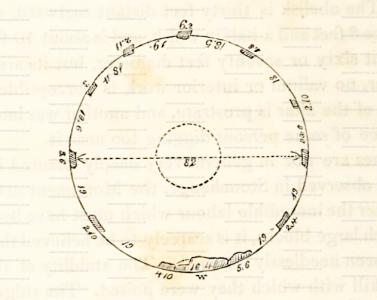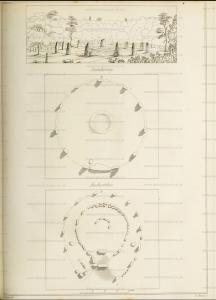Archaeologia Volume 22 Section XV
Archaeologia Volume 22 Section XV is in Archaeologia Volume 22.
Observations on several Circles of Stones in Scotland, presumed to be Druidical: by James Logan, Esq. F.S.A. Edinb. in a Letter addressed to the Right Honourable the Earl of Aberdeen, K. T. President. Read 15th November 1827.

50, York Square, Regent’s Park.
My Lord
Your Lordship having sometime since done me the honour to lay before the Society of Antiquaries, some Drawings and Observations on certain Druidical Circles, I am induced to trouble your Lordship with a similar Communication, in the hope that it also may be received as a slight essay towards a knowledge of such remains, and their probable uses.
These Sketches represent views and plans of several Circles of Stones in Scotland, some of which may be thought curious.
It is not necessary for me to extend my observations respecting their origin and design; the Society being doubtless better informed on that subject. I may, however, be permitted briefly to state that they were devoted to the purposes of worship, to the performance of all solemn and important transactions, as the election of chiefs, trials by combat, which were here decided as in the presence of God the supreme judge, &c. and that they were likewise used as Courts of Justice.
A very early account of these monuments occurs in Scottish history: "Fergus the First,2 if we may credit Hector Boece, "was a great restorer of learning and religion, and caused great Circles, the highest stones towards the south, to be erected."
This was three centuries before the Incarnation, and in that period, of which it must be allowed the records are generally considered fabulous; but these circles were certainly erected in remote ages by the Celtic population of Britain, and remain the impressive monuments of this singular race. Upon the introduction of Christianity the system under which they were raised began to decline. It was strongly assailed by the Christians, who were seconded by those Chiefs who had been converted, and whose influence was exerted to suppress all meeting in these temples. Hence Merddyn, the Caledonian Druid, deplores the fate of that religion which could no longer be openly practised in the raised Circles. When Druidism had been almost banished from the other parts of the island, its votaries found an asylum in Scotland; and Iona, then called "Inish Diminish," the island of the Druids, became their chief retreat in the north, as Mona had formerly been in the south. It so flourished here, that Gwenddollen, the Arch-Druid, is represented by Merdyn, who was his priest, as "gathering his contributions from every extremity of the land." But this prosperity did not long continue, for toward the close of the sixth century it began to decay, and Colan, or Columbus, established himself in its very strong-hold.
This very ancient and primitive worship being proscribed in Scotland, again found protection in Wales, where it was not only tolerated, but publicly professed, and was cherished by many, even until comparatively recent times. Prince Hywel, who died in 1171, thus invokes the Deity: "Attend thou my worship in the mystical grove, and whilst I adore thee, maintain thy own jurisdiction."
The Christian missionaries would naturally resort to the sacred Circles as the most eligible places to exhort the people and attack the lingering superstition, and thus the Bardic fane was transformed into a Christian church, and its massy stones are found to have been not unfrequently employed in the new erection.
But although the rites of Druidism were superseded, a veneration for its monuments did not cease to exist, and the spirit which in later times dictated to the Reformers the policy of demolishing churches and relics of superstition, excited the converts to destroy the Circles. These open temples were not adapted for the Christian religion, and to have held meetings in them on any occasion, would have kept alive popular respect. The church offered the obvious place in which all matters, heretofore decided in the circles of Druidism, ought to be discussed. But this arrangement, being attended with so much inconvenience and impropriety, was opposed by the Clergy, and one of the canons of the Scots church prohibited the laity from holding Courts in churches. This injunction was unnecessary, if meetings had not been at first held in them which were inconsistent with their sacred appropriation. From this, and some other reasons I shall adduce, I have formed an opinion that Moothills were firstraised for such purposes as Churches were considered unfit for. I find no mention of these mounts previous to the introduction of Christianity. They are often dedicated to Saints, and the hill of Scone, the most noted of the kind, was called "Collis credulitatis" and this name it acquired from a celebrated council held on it in 909 by King Constantine and Bishop Kellach, when all present swore to maintain the rights of the churches and of the Gospel. It would seem that when these mounts were appointed for public meetings, they were often raised near the church, itself erected near or in the site of the ancient temple; legislation being intimately connected with the solemnities of religion.
The appropriation of Circles to judicial purposes is well known. Their name in Orkney, Lawting, in Icelandic, Domring and Domthing, Circles of Justice and Courts of Judgment, prove this use, and they continued to be selected for occasional meeting in the absence of a Court or moot hill.
Circles continued to be used as places of meeting, although the practice was discountenanced. In 1380 a Court of Regality was held "apud le stand and Stanes de la Rath de Kingusie," Cart. Abredonensis. The Court Hill was reserved in many grants of land. It was the right of the Superior to assemble his vassals, and exercise his other prerogatives on it. So late as the reign of James the Fourth an importance was attached to this hill. In 1511 a charter of the Barony of Torbolton ordains the " Courthill to be the principal messuage thereof, where the seasing shall be taken."a
Note a. Harl. MS. 4134.
The ponderous masses of these structures that, now in ruin, excite our curiosity and inspire us with astonishment, have most probably preserved so many of them from demolition. Few, however, have entirely escaped the destroying zeal of Christianity, or the subsequent attacks of agricultural improvement.
Of the Circle at Old Keig [Map], four only of the stones remain.b Of these, the altar measures about 14 feet in length, 5 feet 4 inches in breadth, and is 4 feet 8 inches in height outside. Its two lateral stones are in height 6 feet, and 5 feet 4 inches, and 3 feet 6 inches, and 2 feet 4 inches in width at base, respectively. The Circle is traced by a vallum of loose stones, and in the centre is a tumulus or cairn.
Note b. pl. XXIII.

Eight stones remain of the Circle at Balquhain [Map]. The altar is 13 feet long, 2 feet wide, and 4 feet high, and rests on another block, level with the ground. The obelisk is thirty feet distant eastward, of a triangular form, each face 3 feet and a half in width, and is about 10 feet high. The Circle is about sixty or seventy feet diameter, but its area having been ploughed over, no vallum or interior work is perceptible. One of the lateral stones of the altar is prostrate, and another was lately overturned in consequence of some persons digging too near it.
These stones are not in general very deeply planted in the ground. This has been observed in Stonehenge, the Monument at Carnac in Brittany, &c. After the incredible labour which must have been bestowed in procuring such large blocks, it is scarcely to be believed that their height would have been needlessly lessened. The stability of these erections evinces the skill with which they were poised. The ridge or vallum, so often observable, has perhaps been useful in supporting their position.
The Circle at Balgorkar [Map] seems to have consisted of eleven stones, nine only of which remain. The Altar measures 6 feet 9 inches in length, and is 4 feet 6 inches in height outside. The stone at its east end is 6 feet 7 inches high, and 4 feet 6 inches wide at base. About two hundred paces eastward are two stones, a few paces distant from each other, and about seven feet high. These are not seen in the plan.
The Temple at Seanhinny [Map], in the parish of Midmar, seems to remain as it originally stood, at least in the number and position of its stones; and has been, from a proper feeling, surrounded with trees by the proprietor. There is a central small ridge of stones, but it is not clear whether it has been a circle, or a cairn subsequently opened. The whole area seems full of loose stones, which have been probably thrown into it in clearing the neighbouring fields. The altar is 16 feet 4 inches long, 4 feet 6 inches where broadest, and 2 feet 9 inches high. The lateral stones are 7 feet 6 inches, and 6 feet 7 inches in height, by 5 feet 6 inches, and 4 feet 10 inches in breadth at bottom. As I have taken the measurements of this Circle carefully, I think it will be satisfactory to give a plan of it with these inserted.

From this we find, that nineteen feet is the average distance between the stones. The Altar being less, some of the other intervals are made greater. The distance between the two stones in the circle at Old Keig is also nineteen feet. Part of the Altar has been broken off, and lies beside it.

The remains at Auchorthie [Map] are also very entire, and exhibit a curious arrangement. Most part of the exterior line of stones has been filled up, to constitute a fence; it is consequently difficult to determine whether there has been originally any intervening stones in this part, but the inner circles and a part near the Altar are evidently of the original plan. The two stones placed between the exterior and second line are nearly level with the ground. The largest stones are towards the south, but the whole are of rather moderate dimensions. The Altar is 8 feet 6 inches in length. The name may be from the Gaëlic, auch, field, and ortha, prayer.
In conclusion, I shall make one or two general remarks. The Altar stone is always plain on the outside, so much so, in some cases, that I doubt whether it has not been produced by art; the ground is generally lowest on the exterior; and the stone is somewhat higher at its eastern than at the other end.
I am, my Lord,
Your Lordship’s most obedient servant,
James Logan.